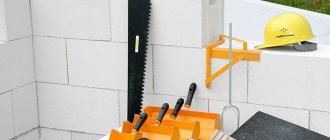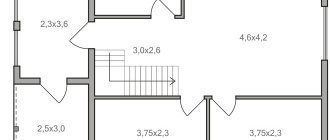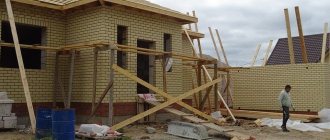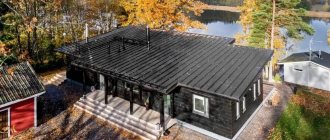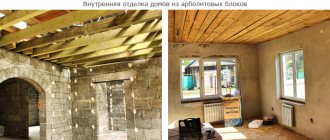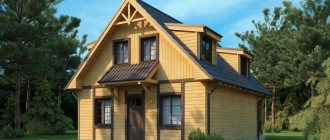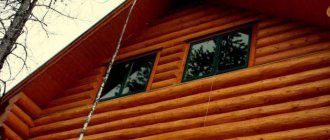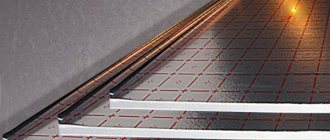Brick is a traditional building material that has been known for centuries. Technical progress does not stand still; new products periodically appear on the construction market. Russian inventors proposed making bricks from environmentally friendly and safe wood. This wooden brick is visually attractive, has a smooth, beautiful surface and all the advantages of natural logs. But there are also numerous “buts” that make this material controversial.
Wooden bricks are suitable for the construction of small structures - verandas, gazebos, etc.
The problem is that its durability is questioned. Experts do not advise building wooden houses from such blocks of large area and number of floors . There is one more big disadvantage - wooden bricks cannot be used in harsh climates; a house made of this building material is extremely unstable in cold weather. For a small dacha in the middle zone, wooden brick can be a real godsend, since it is lightweight and construction from it is quite simple, although a diagram developed by a specialist is required. This material is excellent for constructing extensions, gazebos, and small verandas. In this area, its use is completely justified.
Wooden bricks require a number of manufacturing requirements, so it is not recommended to make them yourself.
Such bricks are made from wood only in factory conditions, since numerous requirements must be met. They concern the selection of wood for work and its processing. It is important that the blocks are as strong as possible, since traditional fasteners cannot be used during installation. There are no seals, plaster, or fittings; as a result, the cost of the house is much less. But on the other hand, it is necessary to strictly follow all the conditions of installation and technology, and not deviate even a millimeter from the project drawn up by a specialist. Therefore, brick made of wood has not yet found wide distribution today. Although, perhaps, in the future it will gain due popularity.
Article on the topic: Order in the country: ways to store garden tools and other things (26 photos)
What it is?
The unusual brick received its name for its resemblance to a well-known building material. In fact, in its composition and properties it is closest to wooden beams, differing from it in its smaller size and installation method. Visually, the material looks like wide blocks measuring 65x19x6 cm; on all its sides there are small grooves and locks with which the blocks are attached to each other. There are also options with smooth edges, but they are not used for the construction of load-bearing walls, but only partitions or cladding.
The production technology for such unusual bricks consists of several stages and is as follows.
- Coniferous wood (cedar, larch, spruce or pine), sawn into beams, is brought to the production site and placed in special chambers for drying. Wood moisture content is reduced to only 8-12%, which allows bricks to better retain heat inside the house.
- The dried timber is machined using special saws. With their help, long material is divided into separate blocks, on which grooves and tongues are cut. The edges are processed to look decorative and fit together with virtually no gaps. This method of connection looks so neat that it does not require any external finishing of either the side walls or the façade of a residential building, unlike conventional timber or brick.
- The finished brick undergoes finishing grinding so that its surface is as even and smooth as possible. This surface can be compared to the surface of wooden furniture, which is made in a factory and not by hand. Finished bricks are most often not painted; they are only tinted with special compounds and impregnations to protect them from the external environment and pests.
Based on the quality of the material, wooden brick, like ordinary timber, is divided into grades. The lowest of them is marked with the letter “C”, and the highest is labeled “Extra”.
The difference between the lowest and highest grade can be about 20-30%. By itself, a cubic meter of this new building material costs 2-3 times more than conventional brick, but its weight is significantly less, which allows you to save on the thickness and depth of the foundation poured for the construction of a house or cottage. The inside of such material can be finished in any of the available ways: covered with plaster and paint, mounted with drywall or wallpaper.
Methods and techniques for making a cutting board
There are two ways to make it - from a single piece of wood or by gluing individual fragments.
The first option is cheaper, but it is short-lived - the wood delaminates over time. And the cutting surface made by the second method is more practical and is not subject to deformation. Boards from solid timber are cut according to the selected template. It is transferred to paper, and then to wood - traced along the contour with a pencil. Then the workpiece is given the desired shape using a jigsaw or hacksaw. Then the product is sanded with sandpaper or a grinding machine, coated with an oil mixture and beeswax.
The procedure for making glued boards is more complicated. The technology for its creation is as follows:
- Selection of wood blocks of equal thickness.
- Sanding the side edges. They should fit snugly against each other.
- Assembling a board from fragments of different colors and textures. Applying special glue to the end parts. Tightening with clamps.
- Sanding - after the glue has completely hardened. It dries in about a day.
- Impregnation with oil in 2-3 steps.
- Drying.
Finished products are packaged in transparent film.
Wooden brick technology: its features and origin of the name
This technology uses environmentally friendly material – wood. And the developed techniques guarantee high speed of construction and the formation of a minimum amount of waste.
The photo clearly shows that the technology got its name “wooden brick” due to the shape of the wooden sides used. They can be called bricks.
Earlier I talked about another technology, which is more of a finishing nature - about finishing the floor with coins. True, one of our readers - Peter - in his commentary suggested a more practical option, consisting of finishing the self-leveling floor with chintz. Read it! This is interesting!
What kind of material is this and what features does it have?
Wooden brick is 100% wood. In cross-section it is a beam. Four of the six edges have grooves for fastening together. At the same time, the lock holds the individual bricks together so tightly that the use of additional compounds and fasteners is not required during installation. The bricks are connected tightly enough and wind blowing is practically excluded. Humidity. The products, due to their small size, do not deform during drying. The moisture content of the brick is around 12%. During the creation of the material, each product is polished to perfect dimensions so that the bricks fit together as efficiently as possible and have the proper appearance. Brick sizes may vary. Length from 315 to 950 mm, width about 190 mm.
Useful tips
To make a high quality epoxy table, it is recommended to follow some rules:
- The resin hardens poorly in high humidity. Condensation may penetrate from the air. To prevent this unpleasant phenomenon, you can hang a film over the tabletop.
- The mixture will harden faster if the tabletop is placed on the radiator. You cannot heat from above, as the surface may become uneven. You need to prepare personal protective equipment - a respirator, goggles and gloves.
- Exposure to ultraviolet rays may cause the countertop to turn yellow. All horizontal surfaces in the “resin affected” area must be covered with polyethylene. If the bubbles do not come out well, it is recommended to warm the surface with a hair dryer or inject acetone from a spray bottle.
These manipulations will reduce surface tension. If you follow all the recommendations and follow the technology, you can quickly master the manufacture of original tables. At the same time, your favorite business can begin to generate income.
woodschool.ru
slabdoska.ru
But not everything is so smooth...
And wooden bricks have their own disadvantages that you need to be aware of. The thermal insulation of such a house may raise doubts. The material must be manufactured without errors and joined without gaps (Fig. 2). Otherwise, water may blow through and get into the cracks, which can even lead to destruction of the structure.
There are many handicraft products on the market, and a material such as wooden bricks must be made on high-precision modern machines. Unfortunately, flaws are often discovered only during operation. To prevent this unpleasant situation, it is worth checking the moisture content of the wood when purchasing a new product.
The idea of using wooden bricks in the construction of houses has a promising future, although the manufacturing technology is still imperfect.
Varieties of composition
The most popular material made from wood concrete was wood concrete, the manufacturing method of which was invented more than half a century ago. Wood concrete is excellent for the construction of small monolithic buildings. The main disadvantage of the material is considered to be high moisture permeability - the outside walls must be treated with a protective layer. In addition, there are certain requirements for room humidity - it should not exceed 72-75%.
Manufacturers of wood concrete constantly took steps to improve the properties of the material and mastered the production of urmalite in the 90s. The new material, thanks to modern technology of mixing the cement part and plasticizers, has received additional strength. In addition, production time has decreased.
Since 2009, urmalite began to be produced under a different name - timfort. If wood concrete is considered pure wood concrete, then Timfort is more wood-polymer concrete. It is stronger and less susceptible to water absorption.
Wood concrete has excellent prospects in the face of increasing environmental requirements. In regions with large wood processing, the production of building materials will solve waste problems. In addition, this is a great business - building materials are always needed. A similar business can be opened even on a small scale by organizing mini-lines.
Raw materials
Wood is a natural material that has high bioenergy properties, which is why it is so comfortable to be in a wooden house. In addition, wood “breathes” and thereby maintains the climate and oxygen balance indoors at an optimal level. The raw materials for the production of wooden bricks are 6 m long edged boards of softwood (pine, spruce, cedar).
The wood used in the production of wooden bricks has strict requirements for the presence of defects, as well as for the percentage of moisture content. According to the developed technology for the production of wooden bricks, lumber is dried to a moisture content of 12±2%, then it undergoes mechanical processing in several stages using high-tech equipment. After the operations of planing the workpiece, milling tenons, guide grooves and forming decorative edges, a finished wooden brick is obtained with high quality processing of all surfaces.
The lumber is sorted and placed in drying bags. To achieve the required humidity of 12±2%, packages of lumber are loaded into drying chambers. Drying of lumber is carried out in Secea automatic drying chambers made in Italy, which allow uniform drying of boards to the required humidity.
Wood as the best material for construction
No one doubts that wood is, first of all, a natural building material that can “breathe”, and therefore have a beneficial effect on humans. But the prices for building a house from rounded timber, let’s say, are not affordable for everyone.
Wooden bricks as a material for building a house
Wooden bricks
Today it is difficult to surprise anyone with new construction technologies .
Various new products appear in our markets every now and then. The production of environmentally friendly, reliable and at the same time inexpensive materials is the main task in the activities of construction creators. It was they who invented wooden building bricks for the construction of a country house.
Houses using WOOD BRICK technology
Finished houses made of wooden bricks have all the advantages inherent in houses made from natural and the most environmentally friendly material - wood. At the same time, they do not have all the disadvantages of houses built from wood with natural moisture, and also have a number of environmental and economic advantages over houses made from dry laminated wood. Houses made of wooden bricks have practically no design restrictions. The material was created to realize any creative plan of the architect and future owner of the house, including a variety of geometric shapes of facades that are impossible to implement with any long wall material. A house made of wooden bricks is a house made of dried wood, it does not require time for shrinkage and drying, it is processed according to all the standards required for the processing of furniture material, it is completely ready for finishing, installation of windows, doors, stairs. You can move into the house and heat it immediately after completion of construction work. The WOOD BRICK construction technology from wooden bricks involves a significant reduction in the time from the project to the delivery of the finished house due to the possibility of combining various stages of design and production work in time. The construction technology consists of assembling a house from prefabricated elements with a patented four-way reliable connection to each other.
Advantages of wooden bricks
- Easy to assemble structure. The material is lightweight and easy to install. One specialist can handle the assembly of the structure. There is no need for additional mixtures, solutions and tools.
- The walls of such a house turn out beautiful and do not require additional finishing.
- Resistance of the building to deformation. Due to the low initial moisture level of the material and small geometric dimensions, the structure does not shrink. There is almost no internal stress in small parts, the walls will not crack. Therefore, windows can be installed immediately.
- Profitable price. If compared with the corresponding volume of laminated veneer lumber, then wooden bricks are 2 - 2.5 times cheaper.
Working draft
For clarity, let me present a working draft. Bathhouse size 35000*55000mm with a relaxation room, washing room and steam room. In creating the project, many years of experience and skills in working in AutoCAD were used. 185 standard parts were modeled in the “solid-state” program environment. Based on them, a structure was assembled in the same environment from 4553 parts. The structure is fastened with cable tensioners in the hollow space of the walls to anchors in the foundation. The accumulated volume is 329 MB in 245 files. I show four types of models below:
What is wooden brick
Wooden brick used for construction consists of 4 elements made from wood:
- Two extended side flanges
- Two cross spacers.
Moreover, their articulation between all elements is ensured using a very reliable connection called a “dovetail”.
Each Brickwood wooden brick is a mechanically rigid structure. The rigidity of bricks is ensured by the reliability of the connections used in them.
You won't miss any of our content if you subscribe. It’s very easy to sign up: just enter your e-mail in the form under this article and click on the “Subscribe to newsletter” button. And you will always be aware of our publications!
Can I do it myself?
Both professional builders and manufacturers of such an innovative material are skeptical about the idea of making wooden bricks at home. To do this, you need to have an entire production workshop in your backyard with high-precision grinding and milling machines. In addition, you will need to purchase certain raw materials, which must meet a whole list of requirements. Almost no one has such capabilities, and those who have them are most likely already engaged in the manufacture and sale of this material.
All experts agree that the installation of such material can be easily done on your own if you follow certain rules.
- Laying bricks should be done exclusively in rows.
- The block should only be laid edge-on to the lock, and not vice versa.
- Laying is carried out in two rows, between which thermal insulation material is laid. These can be either special blocks from a hardware store or ordinary sawdust.
- Every 3 blocks it is necessary to make a transverse bandage to give greater stability and reliability to the elements. This dressing is made of wood, like the masonry itself, and is done on both the inner and outer rows.
Each row of dressing must be shifted by half a brick so that it does not coincide vertically on adjacent rows. This will not only strengthen the structure, but will also allow you to get a beautiful pattern on the front side of the masonry.
Poor floor condition
Preparing the base before laying tiles If the structure is severely damaged, there are two scenarios:
- complete replacement of the wooden floor (flooring and joists);
- removing the floor and pouring the concrete screed.
The second option is best suited for houses with reinforced concrete floors. The first is considered in the case of wooden buildings. Screed is preferable because such floors do not cause problems over time.
As the wood ages, defects such as creaking, rotting, and sagging will reappear. But if tiles are laid on the floor, it is not easy to remove them; serious repairs will be required with labor-intensive removal of the floor covering.
After replacing the base with a wooden one, work is carried out as if the floor is in good condition, starting from point 2. If the decision is made to pour the screed, installation is carried out using the appropriate technology.
Building a wall with your own hands, rules
Non-professionals are allowed to lay wooden bricks on their own, but must comply with certain rules: the product is laid in an orderly manner, maintaining the order is mandatory; the brick is laid edgewise on the lock; For both internal and external rows, transverse ligation is required every three bricks.
This is how you build a wood-brick wall with your own hands
Accordingly, the dressing material must match the masonry material; the coincidence of the dressing with the bricks of the bottom row is not permissible. It is recommended to shift it by half a brick. This is the only way you will achieve the correct design, successful design and hollow wall. Thermal insulation is placed in the space between the inner and outer wall.
The walls of the house must be protected from moisture penetration, and therefore a novice developer must thoroughly study the mechanisms of moisture penetration. We will talk to you in the following articles about which wall structures of a house being built should be focused on first, how to ensure their hydro- and vapor barrier, as well as protection from external moisture.
Thermal insulation of wooden walls
In the case of using technology using wooden hollow bricks filled with heat-insulating material (there is also such a subtype of technology, see video below), the width of the space for thermal insulation can be changed up to 60 cm. In any case, this change will not affect the number of wooden bricks in the masonry . The use of various heat-preserving materials is allowed as thermal insulation. It happens that ordinary sawdust is poured into this space - they perfectly retain heat in the house.
Kitchen glass holder
Published 07/20/2018
At first glance, you wouldn't think that this cute glass holder is made from scrap wood. But that’s exactly how it is, I’ll tell you how to make the same in this instruction.
Construction process
A support beam is used to lay the first row. To which the first row of bricks is attached. In conditions where the temperature drops too low, 2 rows of bricks are built, at some distance from each other. Insulation or simple sawdust is placed in this gap. The total wall thickness can vary from 300 to 600 mm. With this approach, as the wall thickness increases, the consumption of bricks does not increase, only the consumption of heat-insulating material increases. Since the material is completely new, there is no way to accurately say about the durability of wooden brick buildings. However, we can definitely talk about high thermal insulation performance and ease of construction.
Preparing the premises
Before starting repairs, it is necessary to clean the room, remove all dust and construction debris, preferably wet cleaning. After which the insulation procedure is carried out. Next, precise measurements are taken, taking into account all the architectural features of the room. This is done for subsequent calculation of the amount of materials and drawing up an estimate. Their presence will allow you to save money if there is no balance, or eliminate the need to purchase additional materials. The easiest way to count the number of square tiles is with the direct installation method. To do this, you need to calculate the surface area, divide it by the area of one tile. Also take into account the thickness of the grout joint (from 2 to 10 mm) and 10-15% of the material for the breakage. To calculate the number of rectangular tiles, when using decorative ones, when laying diagonally, it is better to use a construction calculator.
Square tiles are easy to calculate
Reviews
You can find many positive reviews on various construction forums and websites. However, there are also those who doubt the reliability of such a design and are even dissatisfied with the resulting construction. Most often this is due to the choice of a dishonest supplier who declared the lowest grade of wood under the “Extra” label. Or this may be due to the fact that the buyer did not calculate the average temperature of the region and built a country or country house from this material in a climate for which it was not intended.
Users note not only the beauty and reliability of wooden bricks, but also its versatility. With its help, not only residential buildings are erected, but also various outbuildings, bathhouses and even garages. The blocks, which look like pieces of a children's construction set, are perfect for building a gazebo or enclosed veranda in the garden, or for constructing and finishing internal partitions. You can use them to build a fence or lay out a flower bed. Those who want to decorate their site with unusual decor can make it into unusual structures in the form of various figures, benches and canopies.
Wooden brick will be a real find for those who love non-standard design solutions and at the same time strive to choose natural materials. It easily combines with stone, tiles and other building materials. And even a person who has minimal experience in the construction industry can handle the construction of a house from such material.
About wooden bricks, see the following video.
Benefits from a home workshop
Such events are conceived only for economic benefit and it is not difficult to calculate. This can be done in a very simple way. The average weight of the block is 20 kg. If we convert all the material used into tons, it turns out that 1 ton of cement, 2 tons of sand, 4 tons of filler were spent on a conventional production cycle. This amount of product will require 6 kg of plasticizer, which will cost 300 rubles. As an example, a building block made of crushed stone is given.
Cost of consumables:
cement 1 ton – 5000 rub.
sand 2 tons – 800 rub.
crushed stone 4 tons – 2400 rub.
plasticizer 6 kg. – 300 rub.
The total cost is 8,500 rubles.
This amount will yield 6 tons of finished products or 300 blocks. The cost amount of 8500 must be divided into 300 blocks, which will give the raw material cost per unit of goods. Thus, the raw material cost of the block amounted to 28.3 rubles. 1.7 rubles should be allocated for energy costs.
Wall surface finishing
After installation, the result is a smooth wall that does not require additional decorative finishing . But experts advise using wax-based impregnations .
The category of decorative and protective preparations from this series includes:
- impregnating paint and varnish substances;
- stains;
- waxes-oils;
- drying oils
Some drugs combine several qualities. For example, a product based on linseed oil with the inclusion of wax and organic resins simultaneously protects against moisture, microorganisms, and decorates the wall.
Most impregnations are water-based and also use organic solvents. The products penetrate deeply and spread between the wood fibers.
Decorative and protective preparations increase the attractiveness of fences, but at the same time increase the risk of fire.
Water-soluble products do not smell , unlike alkyd impregnations. Paints and varnishes additionally protect wooden surfaces from parasites and bugs. Colored products emphasize the wood texture and ennoble the wall. As a result, tinted pine looks like expensive mountain ash or mahogany . Light material can be given a dark shade, and vice versa.
Wax materials using husky colors, green and white tints look interesting. Impregnations are not paints in the literal sense; they only emphasize the shade, but do not provide a bright film. Products based on oils and wax give a shimmer and highlight the natural beauty of wood.

